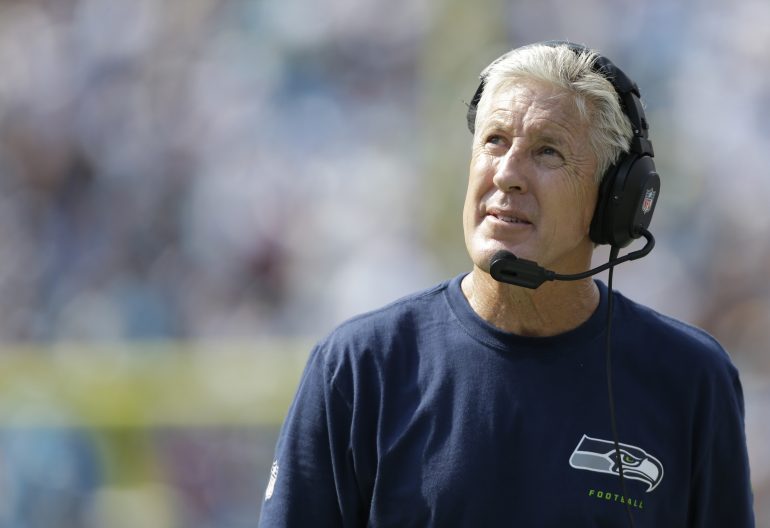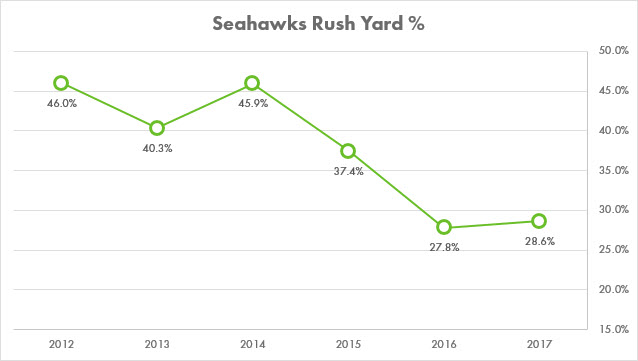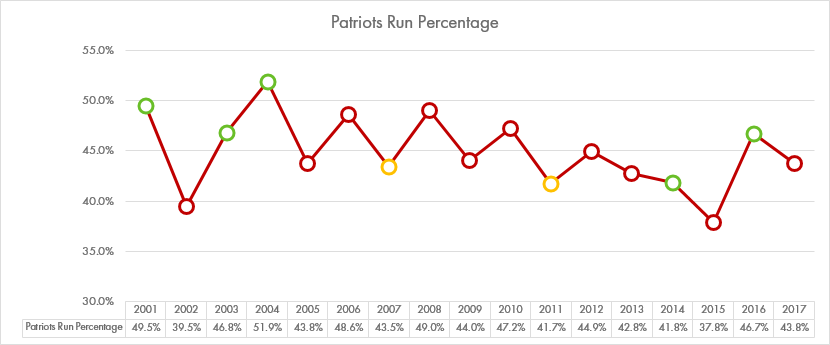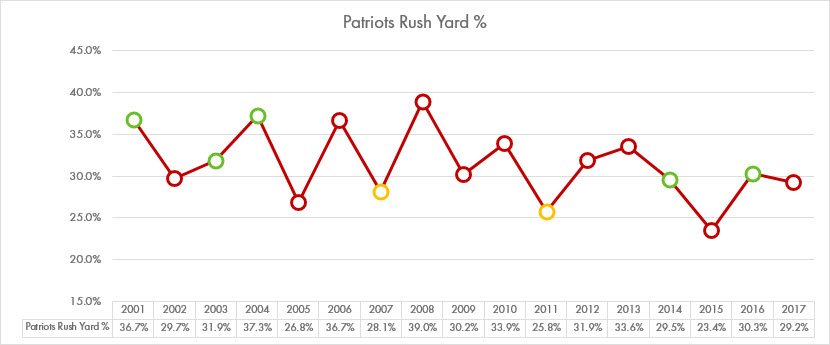Let’s get this out of the way from the jump. Every super smart mathematician or economist I have heard from or read, has made it clear that effective passing is far more valuable than effective running in football. They speak a language I only understand a portion of, but I can follow enough to get the basic point that anything resembling advocacy for running the ball is tantamount to suggesting NBA teams should favor low post scoring over three-pointers. If that doesn’t make sense, just know suggesting teams should run the ball means you are an NFL luddite who is arguing against math. Math tends to win most arguments it enters.
Despite the public shaming I will receive for writing this article, I choose to carry on like all good luddites. The growing horde on Twitter who want Pete Carroll to give up on the run game and just throw the ball with MVP-to-be Russell Wilson are misguided. This team is at it’s best when they have balance on offense. Wilson is at his best when he has balance on offense. And based on some (vastly inferior) math of my own, there is some evidence that all teams are better off that way.
I should explain a little bit about what I mean by balance. There are at least a few different ways to quantify it. One way is looking at the percentage of run plays versus pass plays. Another is to look at the percentage of total yards gained on the ground versus through the air. I’m sure there are more, but those are the ones I am going to look at for now. Balance implies equality between the two. That is never going to happen on yardage as passing yardage almost always outstrips rushing yardage (cue frustrated mathletes everywhere shaking their fists at the screen saying, “EXACTLY!”). Play selection is something that can balance to 50/50.
Let’s start by taking a look at what the play selection mix has been like for Seattle over the past few seasons.
If we assess balance by how close a team is to a 50/50 split, one could argue that the Seahawks were roughly as unbalanced in 2012 as they have been this season. Seattle ran the ball 57% of the time back then and have passed the ball 58% of the time this season. Different emphasis, but same level of unbalance. The two Super Bowl seasons got closer to balance and 2015 was nearly perfect in that regard. It should be noted that 2015 was the offense that produced the most points and yardage of this run. In fact, the 423 points scored was the second highest total in franchise history, behind only the 2005 Super Bowl squad.
All semblance of balance was lost last season as the team threw the ball 62% of the time, but has recovered a bit this year. Play calls are one lens. Let’s see how the yardage has been distributed.
Remember, the realistic goal here is not a 50/50 split as pass yards per play are almost always greater than rush yards. The average yards per pass attempt in the NFL this season is 7.1. The average yards per rush this season is 4.1. The average team ran around 1000 plays last season. If they were to hit a perfect balance of run and pass plays and average 4.1 on run plays and 7.1 on pass plays, the would wind up with 2,050 rush yards and 3,550 pass yards, or a 36.6% rush yard rate. That gives us at least some frame of reference about what balance looks like when it comes to rush yard percentage.
It should come as no surprise, then, that the Seahawks 2015 season where they came closest to a balanced play sheet, is the season where they are closest to a balanced rush yard percentage. You can see that the 2014 season was noteworthy because that was the second-closest season in terms of play call balance (54% rush rate), but their rush yard percentage was second-highest. The reason was they were extremely efficient running the ball. That was the season where Wilson nearly rushed for 1,000 yards himself. His yards per carry was quite high.
Looking at the Seahawks numbers helps to provide a baseline, but comparing them with a successful team that is known to rely heavily on the pass would provide some more context. No team is more associated with success or passing over the last two decades than the New England Patriots and Tom Brady. Let’s look at their run rate over Brady’s career.
I color-coded the Super Bowl years. Green are years they won the Super Bowl. Yellow are years they lost the Super Bowl. Their first Super Bowl was marked by nearly perfect balance of run and pass with a 49.5% run rate. They dipped considerably the following year to over 60% passing and did not make it back. They were again pretty balanced in 2003 (47/53 run/pass) and even more balanced in 2004. Their play selection bounced around a bit after that, but generally stayed within a narrow band that never saw more than about 56% passing until 2011 when it jumped to 58% passing. None of their Super Bowl seasons came with an offense that passed more than 58.3% of the time. Only one of their four Super Bowl winning seasons came when their pass rate was higher than 53.3%. Let’s see how that translates to yardage.
Remember that perfect balance here looks something like 36-37% rush yardage. New England nailed that in two of their first three Super Bowl wins. Interestingly, they have never won a Super Bowl without getting at least 30% of their yards on the ground. Even the 2014 Super Bowl winning season where they ran the ball just 41.8% of the time came with 29.5% of the yards on the ground. Both Super Bowl losses came in years where they were near the bottom of their balance numbers. Despite popular opinion, the Patriots have succeeded with balance on offense.
As it stands, Seattle is less balanced this season than the Patriots. They run the ball less often and for less of a percentage of their total yards. Neither Seattle nor New England have made the Super Bowl with an offense that has passed the ball more than ~58% of the time. Neither have won a Super Bowl with an offense that has gained ~30% of their yards on the ground. The Seahawks currently stand at 58.4% pass plays and 28.6% rush yards. Increasing the pass rate even more seems unwise if your goal is to build a championship team.
Seahawks fans who thought this most recent win against the Eagles was the Seahawks best of the season might be interested to know the team passed the ball 56.9% of the time and had 32.6% of their yards on the ground. Wilson had just 31 pass attempts and the team had just 209 passing yards. That was his lowest number of pass attempts in seven games, which is part of what sparked my interest in this topic. I have noticed that some of the Seahawks best offensive performances and victories tend to come in games when Wilson throws for less than 250 yards, but has a high number of touchdown passes.
I recall a few different times he threw for 3 or more touchdowns, but had less than 250 yards passing. Those games tend to be accompanied by a more productive rushing offense as well. I set out to test my memory, and found some fascinating results.
Balanced offense is easier to accomplish and more successful
The first thing I did was look up games where the Seahawks had at least 3 passing touchdowns, no more than 250 passing yards, and over 100 rushing yards since 2010 when Carroll arrived. It turns out there have been seven such games during the regular season and one in the playoffs. All came after Wilson started in 2012. The Seahawks are 8-0 in those games. I decided to broaden the search to all teams, and look back all the way to the 2000 season to see how the rest of the league fared in these types of games.
There were 355 regular season games where this occurred, and teams were a combined 305-50 (0.859 win percentage) in those games. There were an additional 12 games that met those criteria in the playoffs, and teams were a perfect 12-0 in those games. Pretty good. My next step was to juxtapose that with a game where passing yards were the predominant method of offense.
I looked for games where teams had at least 3 passing touchdowns (same as before), but now had over 300 yards passing and less than 100 yards rushing. The Seahawks have had 5 regular season games that met that criteria, and are 2-3 in those games. They had one playoff game like that and lost it, to bring their overall total to 2-4 in those games. Expanding that out to all teams since the 2000 season like we did earlier, we find that there have been 300 regular season games and 24 postseason games that met this heavier passing scenario. Teams were 167-133 (0.557 win percentage) in those regular season games and 13-11 (0.542) in the postseason for a total of 180-144 (0.556).
There are at least two things I take away from that information. First, teams appear to be far more successful when they have a mix of run and pass yardage than when passing is their dominant method of gaining yards. Second, it appears easier for teams to achieve that balance than to go off in the passing game as evidenced by 55 more regular season games with less than 250 yards passing and more than 100 yards rushing than over 300 yards passing and less than 100 yards rushing.
By the way, I decided to look at even more extreme cases where passing dominated and even gave those games the advantage of an extra passing touchdown just to see if the win rate would jump. Seattle has had three games where they had at least 4 passing touchdowns, 350 or more passing yards, but still less than 100 yards rushing. They are 1-2 in those games. All teams since 2000 are 67-37 in those games (0.644). A super successful passing offense without an accompanying run game simply appears to win less often.
Pete has been misunderstood
A lot of fans and media members have misinterpreted Carroll’s desire for a balanced offense. They have heard it as “run first.” That is not what he has asked for. He wants balance. They see the team’s continued attempts to run the ball as an indication that Carroll is too set in his old school ways and needs to embrace the new way of winning like Brady and the Patriots have demonstrated. Only, the Patriots have also been misrepresented. They have the best quarterback to ever play the game, and they still have a more balanced offense than what the Seahawks have had this season.
Do Seahawks fans really think Wilson should be throwing the ball at a higher rate than Brady? As well as Wilson has played, he is not yet in Brady’s class. Nobody is. Even Brady has benefitted from more balance through his career.
None of this is to say the Seahawks run game is good or even likely to be good. It is just making the case for continued effort to mix run and pass, and to not lose sight of the team they likely need to be to win when it matters most. This idea that we should turn the offense over to Wilson’s arm and stop trying to run the ball is misguided and would ultimately be harmful to the team. Embrace the one or two yard runs from Mike Davis. They are our friend. I will now set my abacus down, and wait for the wiser folks to help convince me otherwise.




